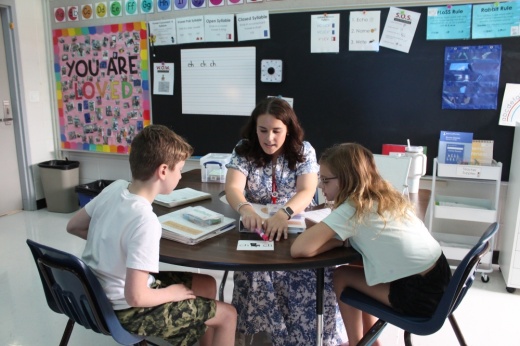The changes are a result of House Bill 3928, passed during the 88th Texas Legislature in 2023. The bill is expected to add additional costs for school districts as it requires more special education student evaluations and staff training.
Eanes, Lake Travis and Leander ISD officials said they already have underfunded special education programs, with districts often spending more than they receive to provide services.
“When special education is not funded at the level it needs to be, it impacts our other kids,” EISD Chief Financial Officer Chris Scott said.
Current situation
The new state law requires Texas districts to transition all students needing dyslexia instruction from a Section 504 Plan to an Individualized Education Program, or IEP, by the start of the 2025-26 school year.
Both 504 Plans and IEPs accommodate individuals with disabilities, but IEPs outline academic goals and specialized instruction created through Admission, Review and Dismissal committee meetings, or ARD meetings, according to the National Education Association.
The bill mandates that certain staff must have advanced qualifications to participate in ARD meetings, which may require additional education and training. To evaluate students, these staff must either: be a licensed dyslexia therapist, have “the most advanced dyslexia-related certification,” or meet additional training requirements adopted by the State Board of Education.
In Leander ISD, the transition from 504 Plans more than doubles the amount of dyslexic students needing IEPs, going from 1,065 to over 2,200 based on 2023-24 enrollment.
“If you bring more expertise to the individual who’s involved, the student will respond better to the services because they’re being delivered appropriately and adequately,” said Steven Aleman, senior policy specialist for nonprofit advocacy group Disability Rights Texas.
Zooming in
The new bill shifts the evaluation process to see if students qualify for special education instruction, EISD Special Education Director Matt Zemo said.
Under the new law, required participation in ARD meetings takes away time from working directly with students, increasing the caseload for special education staff, LTISD and LISD officials said.
In LISD, the district has accrued expenses to train and incentivize staff as well as hire two new positions to meet the new requirements, which were implemented without additional state funding.
LISD and EISD are providing financial incentives for teachers to get their special education certifications so they can manage student cases, district officials said.
Also of note
A 2016 investigation by the Houston Chronicle found that the Texas Education Agency penalized districts when their special education enrollment surpassed 8.5% of students. A corrective action plan issued by the U.S. Department of Education in 2018 included concerns about the exclusion of dyslexia from special education services.
The new protocol has resulted in an increase in students receiving special education services in both LTISD and LISD, district officials said.
In LTISD, enrollment for special education students has grown at a faster rate than enrollment for students receiving general education instruction, Superintendent Paul Norton said at an Aug. 21 board of trustees meeting.
Breaking it down
The amount of special education funding EISD receives has not changed much over the past decade, Scott said. While the district receives $11,000-$12,000 per student annually, it spends over $20,000.
Further funding challenges came last year when a federal audit found the Texas Health and Human Services Commission received funding for some services that were billed improperly. LTISD lost nearly $285,236, while EISD lost around $448,000, per Texas HHSC documents. LISD was notified it owed HHSC $183,000 when it expected to receive $7 million, LISD Chief Financial Officer Pete Pape said.
The reduction has created uncertainty among districts on which student services are covered, said Jennifer Freeman, LTISD executive director for special services.
Diving in deeper
Zemo said filling EISD special education teacher aide positions is the program’s “biggest area of work,” though hiring has improved in the last year.
To limit its fiscal year 2024-25 budget shortfall, LTISD cut around 24 vacant positions and $580,000 in contracted services for special education, according to district documents. The district started the school year with 16 vacant special education teacher and aide positions.
“We’re facing some challenges just in general with filling special education positions. To have that increase in [special education] caseload can be a little bit difficult,” Freeman said.
Going forward
Despite increased costs, LISD officials said they are committed to improving their services. The district’s next big investment is a new 18-plus program facility for adult special education students opening in 2025. In LTISD, district officials are holding listening sessions with staff and engagement nights with families regarding special education, Freeman said.
“We’re really trying to strengthen our partnerships and education with our families ... [to] make a really comprehensive plan as far as improvement,” she said.
Local education foundations are also looking to lessen the special education funding gap. In April, two EISD parents created the Special Education Endowment Fund through the Eanes Education Foundation that has $130,000 as of August, which will go toward:
- Professional development and training
- Teacher recruitment/mentoring support
- Inclusive extracurricular programs
Ahead of the 89th Texas legislative session in January, district officials are compiling a list of priorities outlining more funding for:
- Special needs services
- Mental health resources and staffing
- Unfunded safety mandates
- Increase to the basic allotment per student






